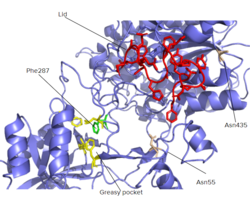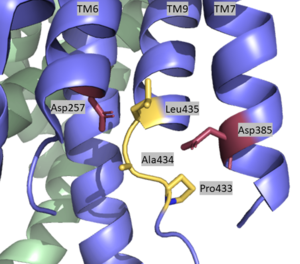Sandbox Reserved 1619
From Proteopedia
(Difference between revisions)
| Line 7: | Line 7: | ||
===Background=== | ===Background=== | ||
| - | Gamma Secretase is a transmembrane | + | Gamma Secretase is a transmembrane [https://en.wikipedia.org/wiki/Aspartic_protease aspartatic protease]. It catalyzes peptide bond hydrolysis of type I integral membrane proteins such as [https://en.wikipedia.org/wiki/Notch_proteins Notch], [https://en.wikipedia.org/wiki/Amyloid_precursor_protein APP], and various other substrates. It recognizes and catalyzes the reaction with its substrate using 3 residue segments. These substrates generate amyloid-β (Aβ). This product is important for various neural processes, and it is well known for its Implications with Alzheimer’s disease (AD). This has made gamma secretase a popular drug target, specifically using gamma secretase (GS) inhibitors. However, due to the nature of gamma secretase having various neural functions, there are dangerous side effects when it is inhibited. |
===Overall Structure=== | ===Overall Structure=== | ||
| - | Gamma-secretase is composed of 20 transmembrane components (TMs) and has 4 subunits: Nicastran, Anterior Pharynx-defective 1, Presenilin, and Presenilin Enhancer 2. These subunits are stabilized by hydrophobic interactions and 4 phosphatidylcholines.These phosphatidylcholines have interfaces between: PS1 and PEN-2, APH-1 and PS1, APH-1 and NCT. | + | Gamma-secretase is composed of 20 transmembrane components (TMs) and has 4 subunits: Nicastran, Anterior Pharynx-defective 1, Presenilin, and Presenilin Enhancer 2. These subunits are stabilized by hydrophobic interactions and 4 [https://en.wikipedia.org/wiki/Phosphatidylcholine phosphatidylcholines]phosphatidylcholines.These phosphatidylcholines have interfaces between: PS1 and PEN-2, APH-1 and PS1, APH-1 and NCT. |
Nicastrin (NCT) has a large extracellular domain and 1 TM. It is important to substrate recognition and binding. | Nicastrin (NCT) has a large extracellular domain and 1 TM. It is important to substrate recognition and binding. | ||
Presenilin (PS1) serves as the active site of the protease and contains 9 TMs, each varying in length. The site of autocatalytic cleavage is located between TM6 and TM7 in PS1 and major conformational changes take place in this subunit upon substrate binding. | Presenilin (PS1) serves as the active site of the protease and contains 9 TMs, each varying in length. The site of autocatalytic cleavage is located between TM6 and TM7 in PS1 and major conformational changes take place in this subunit upon substrate binding. | ||
Revision as of 22:14, 6 April 2020
Gamma Secretase
| |||||||||||
References
- ↑ Bai XC, Yan C, Yang G, Lu P, Ma D, Sun L, Zhou R, Scheres SH, Shi Y. An atomic structure of human gamma-secretase. Nature. 2015 Aug 17. doi: 10.1038/nature14892. PMID:26280335 doi:http://dx.doi.org/10.1038/nature14892
Student Contributors
Layla Wisser
Daniel Mulawa


